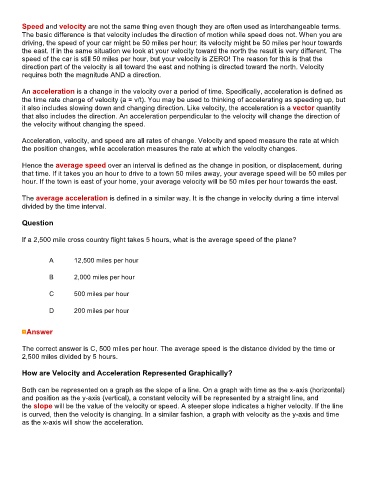Page 349 - ABCTE Study Guide_Neat
P. 349
Speed and velocity are not the same thing even though they are often used as interchangeable terms.
The basic difference is that velocity includes the direction of motion while speed does not. When you are
driving, the speed of your car might be 50 miles per hour; its velocity might be 50 miles per hour towards
the east. If in the same situation we look at your velocity toward the north the result is very different. The
speed of the car is still 50 miles per hour, but your velocity is ZERO! The reason for this is that the
direction part of the velocity is all toward the east and nothing is directed toward the north. Velocity
requires both the magnitude AND a direction.
An acceleration is a change in the velocity over a period of time. Specifically, acceleration is defined as
the time rate change of velocity (a = v/t). You may be used to thinking of accelerating as speeding up, but
it also includes slowing down and changing direction. Like velocity, the acceleration is a vector quantity
that also includes the direction. An acceleration perpendicular to the velocity will change the direction of
the velocity without changing the speed.
Acceleration, velocity, and speed are all rates of change. Velocity and speed measure the rate at which
the position changes, while acceleration measures the rate at which the velocity changes.
Hence the average speed over an interval is defined as the change in position, or displacement, during
that time. If it takes you an hour to drive to a town 50 miles away, your average speed will be 50 miles per
hour. If the town is east of your home, your average velocity will be 50 miles per hour towards the east.
The average acceleration is defined in a similar way. It is the change in velocity during a time interval
divided by the time interval.
Question
If a 2,500 mile cross country flight takes 5 hours, what is the average speed of the plane?
A 12,500 miles per hour
B 2,000 miles per hour
C 500 miles per hour
D 200 miles per hour
Answer
The correct answer is C, 500 miles per hour. The average speed is the distance divided by the time or
2,500 miles divided by 5 hours.
How are Velocity and Acceleration Represented Graphically?
Both can be represented on a graph as the slope of a line. On a graph with time as the x-axis (horizontal)
and position as the y-axis (vertical), a constant velocity will be represented by a straight line, and
the slope will be the value of the velocity or speed. A steeper slope indicates a higher velocity. If the line
is curved, then the velocity is changing. In a similar fashion, a graph with velocity as the y-axis and time
as the x-axis will show the acceleration.

